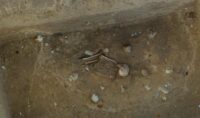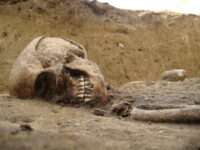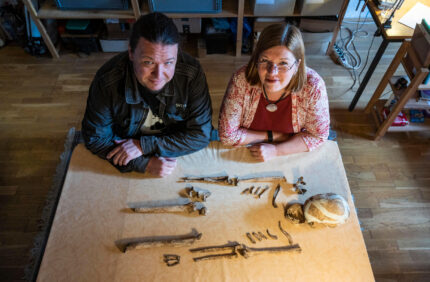 The skeleton of a prehistoric woman discovered in Bietikow, Germany, has been discovered to be a rough contemporary of Ötzi, the glacier mummy discovered in the Ötztal Alps, at more than 5,000 years of age. The skeletal remains were discovered in May in the Uckermark district of northeastern Brandenburg. The area has been settled since the Neolithic and is home to numerous Bronze Age burial mounds and megaliths, so an archaeological survey was performed before construction of new wind turbines. Archaeologists found the skeleton in crouch position, one of the oldest forms of funerary positioning common in the late Neolithic.
The skeleton of a prehistoric woman discovered in Bietikow, Germany, has been discovered to be a rough contemporary of Ötzi, the glacier mummy discovered in the Ötztal Alps, at more than 5,000 years of age. The skeletal remains were discovered in May in the Uckermark district of northeastern Brandenburg. The area has been settled since the Neolithic and is home to numerous Bronze Age burial mounds and megaliths, so an archaeological survey was performed before construction of new wind turbines. Archaeologists found the skeleton in crouch position, one of the oldest forms of funerary positioning common in the late Neolithic.
The burial was not part of a cemetery. The woman was buried in a pit within a settlement. The gravediggers enlarged the pit and bordered it with field stones. Despite the care given to the placement of her body, she had no grave goods. The finds made elsewhere on the dig dated from the Neolithic to the Early Bronze Age (5500 – 2000 B.C.), so when she was first unearthed the only preliminary dating possible was the 3500-year date range of the site as a whole.
 The remains were recovered for further study and now the first of the results have been announced. Radiocarbon dating found that she lived between 3400 and 3300 B.C., overlapping on the recent end with Ötzi who went on his last Alpine hike between 3360 and 3100 B.C. She was between 30 and 45 years of age at the time of her death.
The remains were recovered for further study and now the first of the results have been announced. Radiocarbon dating found that she lived between 3400 and 3300 B.C., overlapping on the recent end with Ötzi who went on his last Alpine hike between 3360 and 3100 B.C. She was between 30 and 45 years of age at the time of her death.
She did a lot of damage to her teeth those three or four decades.
It was during the Neolithic period that humans first introduced grains into their diet, since they could be stored more easily than meat and could also be used as a means of payment, according to anthropologist Bettina Jungklaus.
However, this led to a deterioration in people’s general health. This can be seen in the state of the Lady of Bietikow’s teeth, which are severely eroded and missing completely in some places, Jungklaus said.
“Normally there is enamel on the surface of the teeth. But here it is heavily worn, chewed off,” she said.
“This allows us to draw conclusions about her diet: it was probably very rich in fibre, very hard. There are certain grains that cause the teeth to wear out easily.”
It’s possible those hard grains may have played a role in her death, as such damaged teeth could easily have developed dental abscesses. Egyptian mummies are absolutely riddled with them thanks to the prevalence of coarsely-ground grain in the Egyptian diet, and some of them were even killed by infections caused by caries and abscesses.
Studies on the Lady of Bietikow are ongoing. Researchers will examine the bones for signs of injury, disease, nutrition and look for a cause of death. DNA analysis will seek her genetic origin, revealing if she has ancestors from the region or came from somewhere else. The teeth will be subjected to strontium isotope analysis to determine where she was born and raised.
